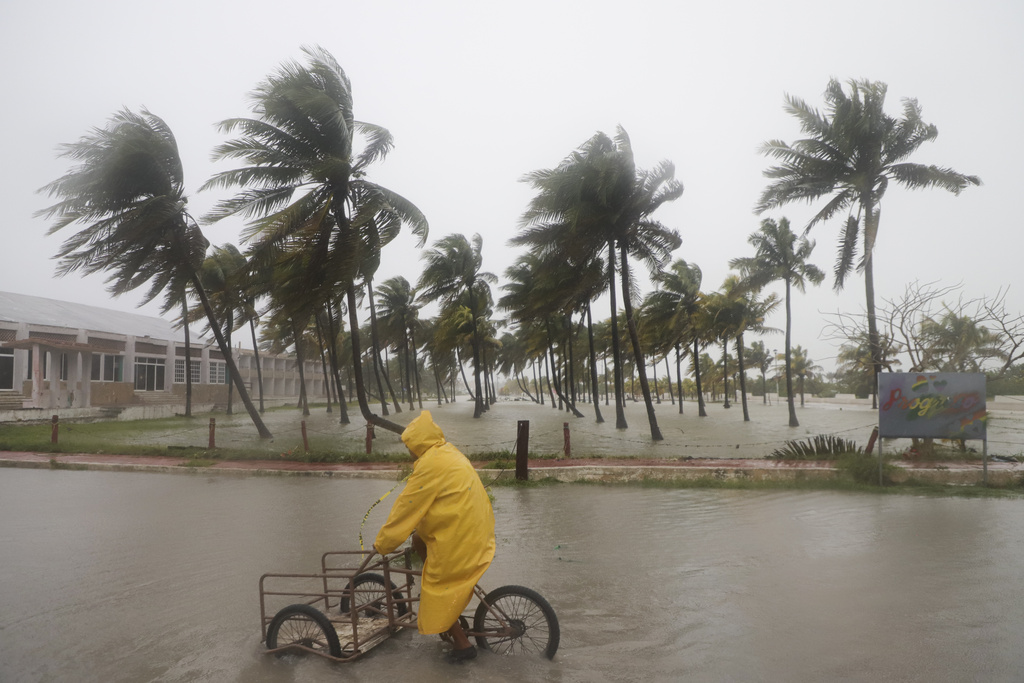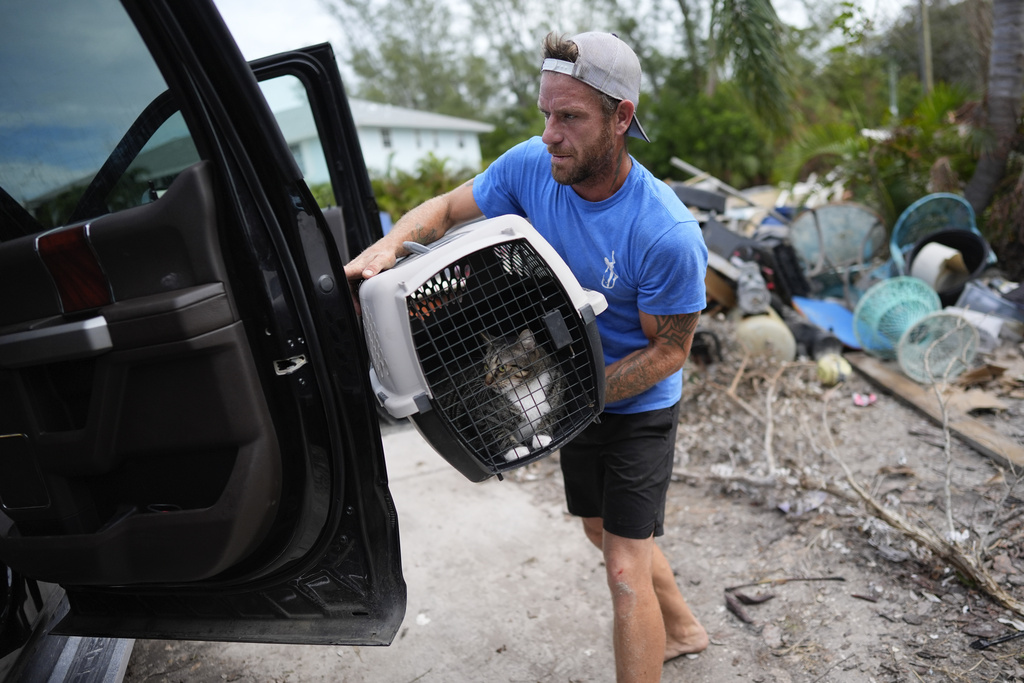Hurricane Milton Targets Florida With Record-High Storm Surge \ Newslooks \ Washington DC \ Mary Sidiqi \ Evening Edition \ Hurricane Milton has intensified into a Category 5 storm as it approaches Florida’s Gulf Coast, threatening areas like Tampa Bay with unprecedented storm surges and destructive winds. With evacuation orders in place, the region is still recovering from the effects of Hurricane Helene just two weeks ago. Forecasters expect the storm to make landfall late Wednesday, and experts have labeled this hurricane season as one of the most unusual on record.

Hurricane Milton Quick Looks:
- Category 5 hurricane targets Florida’s Gulf Coast, specifically the densely populated Tampa Bay area.
- Forecasts predict unprecedented storm surges of 10-15 feet in Tampa Bay, with evacuation orders already in place.
- Traffic congestion and fuel shortages complicate evacuation efforts as residents flee the region.
- Florida is still recovering from Hurricane Helene, which struck only two weeks earlier.
- Rapid intensification: Milton evolved into a Category 5 storm in just 46.5 hours, one of the fastest on record.
Deep Look:
Hurricane Milton, now a powerful Category 5 storm, is set to deliver a potentially catastrophic blow to Florida’s Gulf Coast, particularly the Tampa Bay area, which has not faced a direct hit from a major hurricane in over a century. With sustained winds of 165 mph and the potential for life-threatening storm surges, Milton is poised to become one of the most destructive hurricanes in the state’s history.
On Tuesday, as Milton gathered strength in the Gulf of Mexico, authorities in Florida scrambled to issue evacuation orders for vulnerable areas along the coast. The Tampa Bay region, home to over 3.3 million residents, is under particular threat, with storm surges projected to reach between 10 and 15 feet. This level of surge could easily flood coastal communities and potentially submerge homes, leading to dire warnings from local officials. Tampa Mayor Jane Castor has cautioned that staying behind during the storm is akin to a death sentence, describing the dire consequences for those choosing to ride out the hurricane.
Traffic began to thicken Tuesday afternoon as thousands of Floridians left the area, causing bottlenecks on highways and in key evacuation zones. Alongside the rush to evacuate, crews worked feverishly to clear debris left by Hurricane Helene, which made landfall just two weeks earlier, to prevent it from becoming dangerous projectiles during Milton’s approach. The overlap of two hurricanes in such a short time frame has put immense pressure on Florida’s emergency response systems.
According to the National Hurricane Center, Milton is expected to maintain its strength as a dangerous hurricane when it hits the Florida coast late Wednesday. By Tuesday afternoon, the storm was about 480 miles southwest of Tampa, and forecasters warned of widespread devastation. Florida Governor Ron DeSantis urged the public to take the storm seriously, preparing for what could be “a major, major impact” along the west coast of the state. The severity of the situation prompted President Joe Biden to postpone an overseas trip, choosing instead to remain at the White House to oversee federal disaster response efforts. Biden remarked that Milton could potentially be one of the worst hurricanes to hit Florida in the last 100 years.
Unusual Hurricane Season Baffles Experts
The arrival of Hurricane Milton is just one of several extraordinary events in what scientists are calling a highly unusual and unprecedented hurricane season. Forecasters initially predicted an active season, but the storm activity tapered off unexpectedly from mid-August to late September. Then, in a dramatic reversal, the Atlantic Basin saw five hurricanes form in quick succession from September 26 to October 6 — more than doubling the previous record for hurricane development during this time.
The unusual nature of the season has prompted meteorologists and researchers to reflect on the rapid intensification of these storms. Colorado State University hurricane expert Phil Klotzbach noted that Hurricane Milton’s transformation from a tropical storm with 40 mph winds to a Category 5 powerhouse took just 46.5 hours, one of the fastest intensifications on record. Such developments, experts say, may be fueled by warmer ocean temperatures, which provide more energy for tropical systems to strengthen rapidly.
In addition, three hurricanes — including Milton — were active in the Atlantic at the same time earlier this week, a phenomenon that has never been observed in October. These anomalies, coupled with the sheer number of major hurricanes this season, have led to renewed discussions on the impact of climate change on storm intensity and frequency.
Potential Destruction from Storm Surges
Forecasters have expressed particular concern about the potential for life-threatening storm surges along Florida’s west coast, especially in the Tampa Bay area. The predicted 10 to 15-foot surge could inundate entire neighborhoods, with water levels potentially rising higher than the rooftops of single-story homes. Tampa has not experienced a storm of this magnitude in decades, making this event especially alarming. Hillsborough County, where Tampa is located, ordered mandatory evacuations for areas closest to the bay, as well as all mobile and manufactured homes, warning residents to leave the area by Tuesday night.
Meanwhile, Florida’s Gulf Coast is still reeling from Hurricane Helene, which made landfall just 150 miles north of Tampa in the Florida Panhandle. Helene caused significant flooding in the Tampa Bay region due to storm surges that reached 5 to 8 feet above normal tide levels. Milton’s forecasted surges are nearly double that of Helene, raising serious concerns about widespread flooding and damage.
In addition to storm surge, Hurricane Milton is expected to bring heavy rainfall as it crosses Florida, dumping up to 18 inches in some areas. The combination of rain and surge could overwhelm local water management systems, leading to severe flooding inland as well as along the coast.
Travel Disruptions and Gasoline Shortages
The approach of Hurricane Milton has caused significant travel disruptions across Florida. Tampa International Airport, one of the busiest airports in the state, ceased operations Tuesday morning, urging residents not to use the airport as a shelter. St. Pete-Clearwater International Airport, also in the evacuation zone, closed shortly after. In Orlando, which is more than 80 miles from Tampa, the Orlando International Airport — the seventh busiest in the United States — announced it would suspend flights Wednesday morning.
Popular tourist destinations like Walt Disney World, Universal Orlando, and SeaWorld also announced closures for Wednesday and Thursday, with Disney likely to extend its shutdown depending on the storm’s impact. These closures mark a rare pause for Florida’s tourism industry, which is already dealing with the aftermath of Hurricane Helene.
The scramble for gasoline has also added to the stress of storm preparations. Long lines and empty gas pumps were reported across the state, especially in the Tampa-St. Petersburg area, where more than 43% of stations were out of fuel by Tuesday morning. Despite assurances from Governor DeSantis that there was no shortage of fuel, many Floridians faced lengthy waits at gas stations. Patrick De Haan of GasBuddy reported that fuel replenishments were ongoing, but the high demand had temporarily overwhelmed supply chains.
Mexico’s Limited Damage
As Hurricane Milton moved toward Florida, it brushed past Mexico’s Yucatan Peninsula, causing only minor damage. In the state of Yucatan, authorities reported downed power lines, fallen trees, and some destruction of small structures, but there were no reported deaths or injuries. Yucatan Governor Joaquín Díaz confirmed that the damage was limited to coastal areas and emphasized that the region had largely escaped the worst of the storm.
As Floridians brace for Hurricane Milton’s arrival, the storm’s path, intensity, and unprecedented surge predictions suggest that it will leave a lasting mark on the state.
Hurricane Milton Targets Hurricane Milton Targets Hurricane Milton Targets







